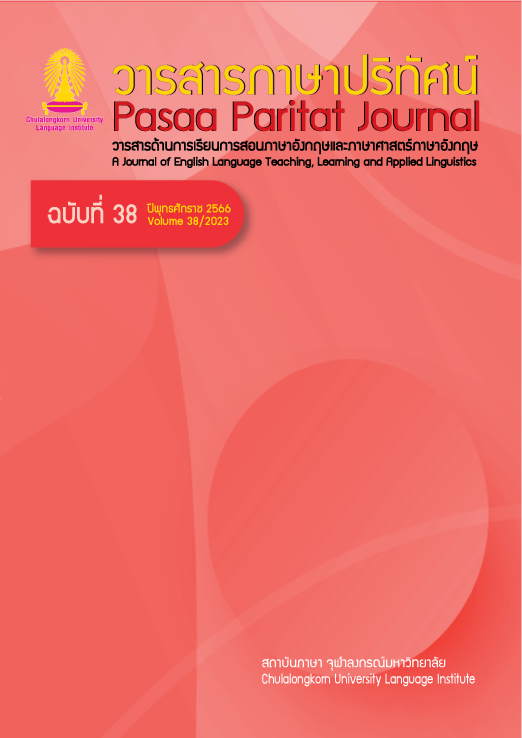Aligning English Grammar in the Thai University Exam with the Common European Framework of References (CEFR)
DOI:
https://doi.org/10.58837/CHULA.PPJ.38.5Keywords:
English grammar, university exam, error types, CEFRAbstract
This study aims to investigate the common error types in the General Attitude Test (GAT) and the congruence of the English grammar tests used for Thai university admission with the CEFR. The sample population consisted of the General Aptitude Test (GAT) from the academic years 2015-2019. The thirty items were examined by focusing on the error identification parts, which was the primary analysis in the current study. The research instruments were the criteria for test-item analysis of error types and the checklist for experts to validate the table of an analysis of error types. The results showed that more than half of the error types (56.67%, n = 17) were errors associated with agreement. It was also found that about 13% (n = 4) of the error types were form of the verb, and 10% (n = 3) were related to derivation of conjunction. The results also indicated that part of speech was most frequently used as a subcategory of agreement, followed by tenses, participle, and subject and verb agreement. In terms of form of verb, the “-ing form” was the most found in the test items, and the subcategory of a derivation of conjunction were the phrase such as and prepositions. In addition, 29 out of 30 (96.67%) items of the English grammar parts in GAT were congruent with the CEFR at the B2 level. Only one item did not match with the CEFR at the B2 level as it was considered relatively complex regarding the structure and grammar of the sentence, which may match at the C1 level instead.
References
Amnuai, W. (2020). An error analysis of research project abstracts written by Thai undergraduate students. Advances in Language and Literary Studies, 11(4), 13–20. https://journals.aiac.org.au/index.php/alls/article/view/6396/4477
Association of the Council of University Presidents of Thailand. (2022). Rai-ngarn Ka Saditi Peauntarn Karnsob GAT/PAT Ra Vishasaman Prajumpee 2565 [Report on basic statistics for GAT/PAT exams and general subjects for the year 2022]. https://www.admissionpremium.com/content/6547
Chan, C. & Mongkolhutthi, P. (2017). The factors affecting student’s choice in studying English at private tutoring schools: A case of Thai upper-secondary school students. Journal of Nusantara Studies, 2(2), 44–52. http://dx.doi.org/10.24200/jonus.vol2iss2pp44-52
Coste, D. (2007, February 6–8). Contextualising uses of the common European framework of reference for languages. [Paper presentation]. The Common European Framework of Reference for Languages (CEFR) and the development of language policies: challenges and responsibilities. Strasbourg, France.
Gass, S., Behney, J., & Plonsky, L. (2013). Second language acquisition: An introductory course. Routledge.
Hawkins, J. A. & Buttery, P. (2010). Criterial features in learner corpora: Theory and illustrations. English Profile Journal, 1(01), 1–23. https://doi.org/10.1017/S2041536210000103
Hawkins, J. A. & Buttery, P. (2009). Using learner language from corpora to profile levels of proficiency: Insights from the English Profile Programme. In Taylor, L. & Weir, C. J. (Eds.), Language testing matters: Investigating the wider social and educational impact of assessment, (pp. 158–175). Cambridge University Press.
Hawkins, J. A. & Filipović, L. (2011). Criterial features in L2 English: Specifying the reference levels of the common European framework. Cambridge University Press.
Livingston, S. A. & Zieky, M. J. (1982). Passing scores: A manual for setting standards of performance on educational and occupational tests. Educational Testing Service.
MacDonald, P. (2016) “We all make mistakes!”. Analysing an error-coded corpus of Spanish university students’ written English. Complutense Journal of English Studies. 24, 103–129. http://dx.doi.org/10.5209/CJES.53273
Office of the Higher Education Commission. (2016). Nayoby Karn Yokradub Mardtatarn Pasaa Anglish Nai Sataban U-domsuksa [Policy of upgrading English education standards of higher education institutions]. Office of the Higher Education Commission, Ministry of Education. http://oldvru.vru.ac.th/acad/SAPA7_2559/075359/นโยบายการยกระดับมาตรฐานภาษาอังกฤษในสถาบันอุดมศึกษา.pdf
Papageorgiou, S., Tannenbaum, R. J., Bridgeman, B., & Cho, Y. (2015). The association between TOEFL iBT® test scores and the Common European Framework of Reference (CEFR) levels (Research Memorandum No. RM-15-06). https://www.ets.org/Media/Research/pdf/RM-15-06.pdf
Sasum, S. & Weeks, B. (2018). Why some Thai students cannot speak English fluently? RSU International Research Conference 2018, 361–367. https://doi:10.14458/RSU.res.2018.144
University of Cambridge. (2011). English Profile: Introducing the CEFR for English. Cambridge University Press.
Downloads
Published
How to Cite
Issue
Section
License
Copyright (c) 2023 Pasaa Paritat Journal

This work is licensed under a Creative Commons Attribution-NonCommercial-NoDerivatives 4.0 International License.



